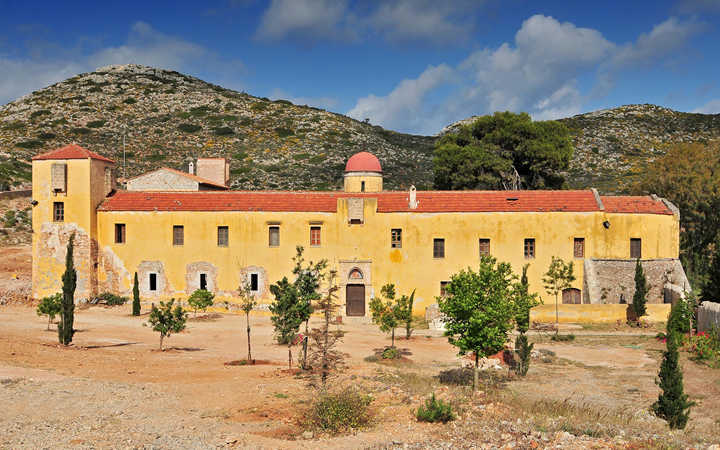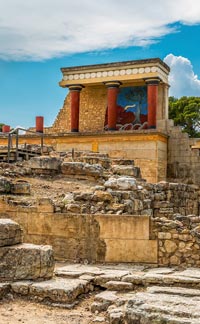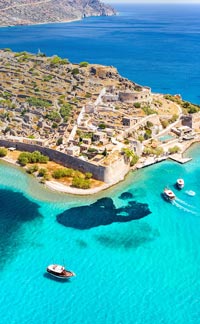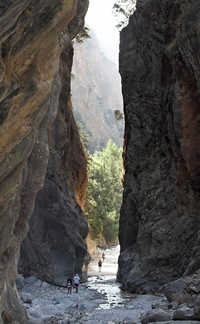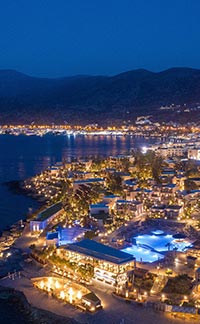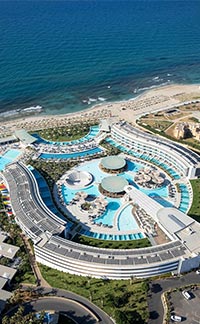If we hold with the image of Crete as a wingless dragon traveling west, that large bulbous thing on the back of its head, which would, geographically, be the north part of west-central Crete, is called the Akrotiri peninsula. At the top of the bulbous thing (or the peninsula), you'll find the historic Gouvernetou Monastery, which is also called Our Lady of the Angels.
Closed on Wednesdays and Fridays, this rust-colored, red-tile-roofed enclosure is a few kilometers south of the north shore of Akrotiri, and 20 km northeast of Chania. Its perimeter walls (actually they're long, narrow buildings), into which the monks' cells are built, also served as defensive walls. It has towers on its corners and an open courtyard measuring 30 x 40 meters. In the courtyard are a few mature trees and masonry-lined beds for flowers and ornamental plants. Dominating the courtyard is the Venetian-inspired quasi-Baroque facade (complete with carved gargoyle faces at the bases of its columns) of the domed church, dedicated to the Virgin Mary.
Sitting 350 meters above sea level on top of a small mountain cluster in the north of the peninsula, with the Stavros Xordakis Wild Animal Refuge just to the west, the monastery is sort of in the middle of nowhere. I say sort of, because down on the plain 5 km south is the very busy Chania International Airport. But all of the land around the monastery is wild, uncultivated and uninhabited by human beings.
Built in 1537, during the heart of Venetian Rule (1205-1669), Gouvernetou is both one of the oldest and one of the largest monasteries on Crete. Its population of monks, numbering 60 during its heyday, still numbers 50. Not bad, for a place that's been around 500 years and requires isolation and abstinence of its residents.
There is a small chapel on one side of the courtyard dedicated to St. John the Hermit, the leader of the "99 Holy Fathers of Crete," a group of ascetics who lived on the island during the Middle Ages. It contains some of the oldest and best-preserved frescoes in Crete.
Bear Cave
There is a path leading north out of the monastery towards the Avlaki gorge and the sea. After about 2 km you'll come to the famous Arkoudospilios, or Bear Cave, which features a stalagmite formation which looks like a crouching bear, and where the goddess Artemis was worshipped in ancient times. There are ruins in the vicinity which likely belonged to monks from Gouvernetou. The "Panagia tis Arkoudias," or "Our Lady of the Bear," was mentioned in a Venetian census dating from 1637. The cave has a small chapel dedicated to the presentation of Christ in the Temple, an event celebrated every year on February 2nd, when locals spend the night in the cave and keep the feast with simple foods and wine.
St. John's Cave and Church
Just a little further on towards the sea on the path you'll come to the Katholikon Monastery (abandoned) and the church of St. John the Hermit, built into the cave of St. John. The cave entrance is a pitched-roof stone facade with a metal, glass-paned door flanked by 2 similarly-designed windows. The cave is 100 meters deep and has an area of 1,500 square meters. St. John the Hermit was said to have lived, and died here, subsisting on greens and carobs.
Further on, where the gorge meets the sea, is a small cove which was used as a harbor to ferry supplies to the monastery.

